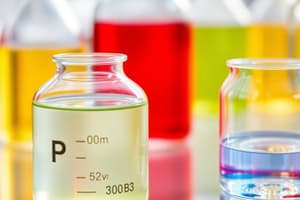Podcast
Questions and Answers
What is an indicator?
What is an indicator?
A dye that changes to different colors in acids and alkalis.
What is meant by a neutral substance?
What is meant by a neutral substance?
A substance that is neither an acid nor an alkali, with a pH of 7.
What does the pH scale represent?
What does the pH scale represent?
A numerical scale from 1 to 14 showing how acidic or alkaline a substance is.
What is a chemical reaction?
What is a chemical reaction?
What is neutralization?
What is neutralization?
What are products in a chemical reaction?
What are products in a chemical reaction?
What are reactants?
What are reactants?
What is salt in a chemical context?
What is salt in a chemical context?
What is an antacid?
What is an antacid?
What is a base?
What is a base?
A neutral substance has a pH of ___
A neutral substance has a pH of ___
A substance with a pH of 2 is classified as an ___
A substance with a pH of 2 is classified as an ___
A substance with a pH of 10 is classified as a ___
A substance with a pH of 10 is classified as a ___
A substance with a pH of 4 is classified as an ___
A substance with a pH of 4 is classified as an ___
A substance with a pH of 5 is classified as an ___
A substance with a pH of 5 is classified as an ___
A substance with a pH of 12 is classified as a ___
A substance with a pH of 12 is classified as a ___
A substance with a pH of 7.4 is classified as ___
A substance with a pH of 7.4 is classified as ___
Flashcards are hidden until you start studying
Study Notes
Acid and Alkali Concepts
- Indicator: A dye that changes color in the presence of acids or alkalis.
- Neutral: Refers to a substance with a pH of 7, indicating it is neither acidic nor alkaline.
pH Scale
- pH Scale: Ranges from 1 to 14, measuring acidity or alkalinity.
- Acids: pH below 7.
- Neutral substances: pH of 7.
- Alkalis: pH greater than 7.
Chemical Processes
- Chemical Reaction: Involves a transformation where new substances are created.
- Neutralisation: A reaction between an acid and an alkali (or base) resulting in the formation of salt and water.
Chemical Entities
- Products: New substances formed during a chemical reaction, located on the right side of a word equation.
- Reactants: The starting substances in a chemical reaction, noted on the left side of a word equation.
- Salt: The substance produced (apart from water) when an acid reacts with an alkali or base.
Practical Applications
- Antacid: A remedy for indigestion, containing a base that neutralises excess stomach acid.
- Base: Any substance that can neutralize an acid, yielding a salt and water in the process.
pH Values
- pH 2: Highly acidic.
- pH 4: Mildly acidic.
- pH 5: Slightly acidic.
- pH 7: Neutral.
- pH 7.4: Slightly basic, typical for bodily fluids.
- pH 10: Mildly basic.
- pH 12: Strongly basic.
Studying That Suits You
Use AI to generate personalized quizzes and flashcards to suit your learning preferences.




